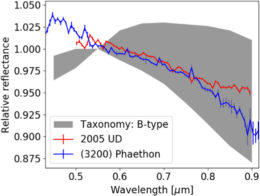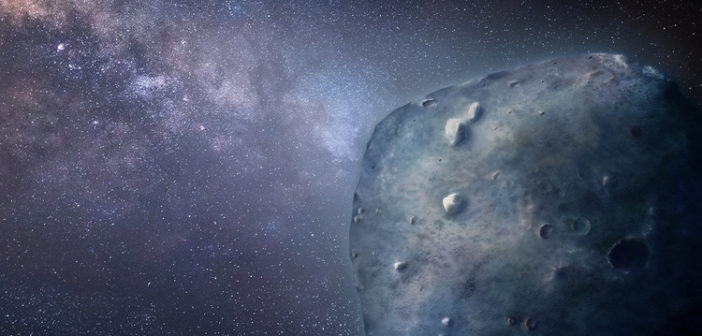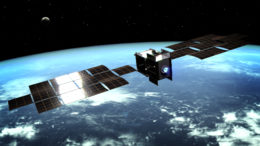It’s not easy being a speeding rock in our solar system.
Over their lifetimes, the millions of minor rocky bodies of our solar system — asteroids — are subject to extreme conditions. Some experience dramatic collisions, some are spun up to such high rotation speeds that they fly apart, and some venture so close to the Sun that our star’s heat cracks them into pieces.Over time, these violent processes create families of asteroids that dance around our solar system on similar paths. Where one rock once orbited, there might now be a group of genetically linked asteroids that follow similar trajectories — all produced by the splitting of one parent rock.
In a new study, scientists have explored two especially nearby asteroids to determine whether they might be linked.
A Visit to a “Potentially Hazardous” Neighbor

The orbital path of the near-Earth asteroid Phaethon. [Sky&Tel]
Perhaps 22,000 near-Earth asteroids are currently known, with just over 2,000 that are large enough and swing close enough to Earth’s orbit to be considered “potentially hazardous” — though it should be noted that the vast majority of these have been ruled out as being an impact threat in at least the next 100 years.
To learn more about these nearby bodies, the Japanese Aerospace Exploration Agency is sending a spacecraft, DESTINY+, to fly by a large (~5-km) near-Earth asteroid. The target is 3200 Phaethon — an unusual blue-toned, dust-producing asteroid thought to be the source of the Geminid meteor stream — and other minor bodies that might be associated with it.As DESTINY+ is currently scheduled to launch in 2022, scientists are currently preparing by learning all they can about the possible mission targets using ground- and space-based observatories. In a new study led by Maxime Devogèle (Lowell Observatory), a team of scientists presents detailed observations of (155140) 2005 UD, another near-Earth object and potential DESTINY+ target that might be related to Phaethon.
Signs Point to a Linked Pair
Devogèle and collaborators gathered an impressive array of observations of 2005 UD, using dozens of telescopes to obtain photometry, polarimetry, and spectroscopy, and also reanalyzing thermal imaging.

2005 UD and Phaethon exhibit very similar spectra, including rare spectroscopic (B-type) signatures. [Devogèle et al. 2020]
But what about 2005 UD’s potential link to Phaethon? Based on Devogèle and collaborators’ observations, 2005 UD and Phaethon appear to share more than just orbital characteristics. They also have very similar — and rare, among asteroids — physical properties as shown by their spectroscopy and polarimetry.
More study is needed, but the data suggest that the two are, indeed, genetically linked — perhaps 2005 UD and Phaethon both split from the same parent thousands of years ago. With any luck, DESTINY+ will soon reveal more about these close-swinging rocky bodies!
Citation
“New Evidence for a Physical Link between Asteroids (155140) 2005 UD and (3200) Phaethon,” Maxime Devogèle et al 2020 Planet. Sci. J. 1 15. doi:10.3847/PSJ/ab8e45



6 Comments
Pingback: From AAS NOVA: “Exploring Links Between Nearby Asteroids” | sciencesprings
Pingback: Exploring Links Between Nearby Asteroids – Sky & Telescope – Ten15AM
Pingback: Exploring Links Between Nearby Asteroids - Sky & Telescope - Worldika - New Platform For Explore World
Pingback: Exploring Links Between Nearby Asteroids – Sky & Telescope | SPACE FORCE
Pingback: Exploring Links Between Nearby Asteroids – Storm-Tech Nomad
Pingback: Exploring Links Between Nearby Asteroids -